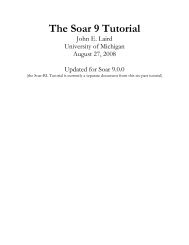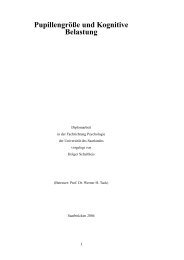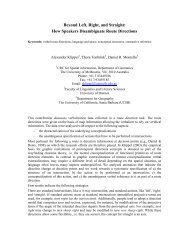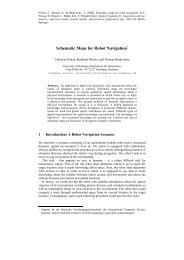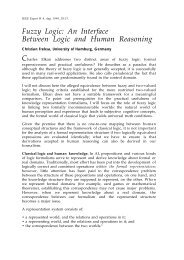SparQ: A Toolbox for Qualitative Spatial Representation and ...
SparQ: A Toolbox for Qualitative Spatial Representation and ...
SparQ: A Toolbox for Qualitative Spatial Representation and ...
You also want an ePaper? Increase the reach of your titles
YUMPU automatically turns print PDFs into web optimized ePapers that Google loves.
The general syntax <strong>for</strong> using the <strong>SparQ</strong> main script is as follows:<br />
$ ./sparq <br />
Example:<br />
$ ./sparq compute-relation dra-24 complement "(lrll llrr)"<br />
where ‘compute-relation’ is the name of the module to be utilized, in this case the<br />
module <strong>for</strong> conducting operations on relations, ‘dra-24’ is the <strong>SparQ</strong> identifier<br />
<strong>for</strong> the dipole calculus DRAc, <strong>and</strong> the rest are module specific parameters, here<br />
the name of the operation that should be conducted (complement) <strong>and</strong> a string<br />
parameter representing the disjunction of the two dipole base relations lrll <strong>and</strong><br />
llrr 6 . The example call thus computes the complement of the disjunction of these<br />
two relations. <strong>SparQ</strong> provides the following modules:<br />
qualify trans<strong>for</strong>ms a quantitative geometric description of a spatial configuration<br />
into a qualitative description based on one of the supported calculi<br />
compute-relation applies the operations defined in the calculi specifications<br />
(intersection, union, complement, converse, composition, etc.) to a set of<br />
spatial relations<br />
constraint-reasoning per<strong>for</strong>ms computations on constraint networks<br />
Further modules are planned as future extensions. This comprises a quantification<br />
module <strong>for</strong> turning qualitative scene descriptions back into quantitative<br />
geometric descriptions <strong>and</strong> a module <strong>for</strong> neighborhood-based spatial reasoning.<br />
In the following section we will take a closer look at the three existent modules.<br />
3.1 Qualification <strong>and</strong> scene descriptions<br />
The purpose of the qualify module is to turn a quantitative geometric scene<br />
description into a qualitative scene description composed of base relations from<br />
a particular calculus. The calculus is specified via the calculus identifier that<br />
is passed with the call to <strong>SparQ</strong>. Qualification is required <strong>for</strong> applications in<br />
which we want to per<strong>for</strong>m qualitative computations over objects whose geometric<br />
parameters are known.<br />
The qualify module reads a quantitative scene description <strong>and</strong> generates a<br />
qualitative description. A quantitative scene description is a space-separated list<br />
of base object descriptions enclosed in parentheses. Each base object description<br />
is a tuple consisting of an object identifier <strong>and</strong> object parameters that depend<br />
on the type of the object. For instance, let us say we are working with dipoles<br />
which are oriented line segments. The object description of a dipole is of the<br />
<strong>for</strong>m ‘(name xs ys xe ye)’, where name is the identifier of this particular dipole<br />
object <strong>and</strong> the rest are the coordinates of start <strong>and</strong> end point of the dipole. Let<br />
us consider the example in Figure 2 which shows three dipoles A, B, <strong>and</strong> C. The<br />
quantitative scene description <strong>for</strong> this situation would be:<br />
6 Disjunctions of base relations are always represented as a space-separated list of the<br />
base relations enclosed in parentheses in <strong>SparQ</strong>.



